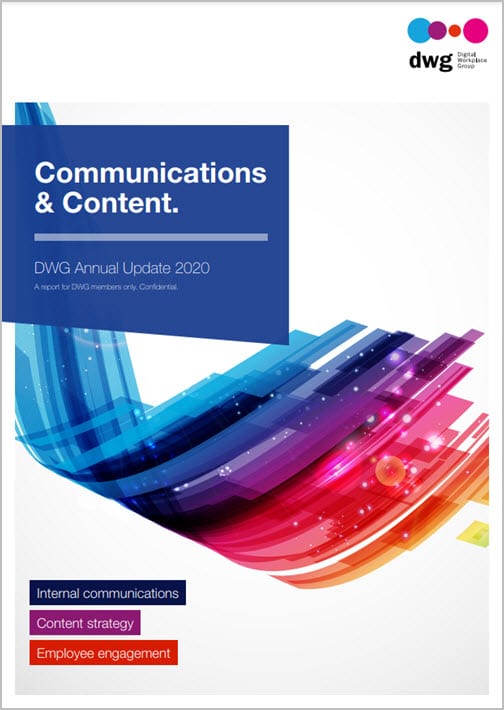Why content management is the catalyst for a great digital employee experience – 5 pointers to getting started
Research the definition of a digital workplace and you’ll find a topic shrouded in subjectivity, as outlined in the article ‘What is a digital workplace?’ by ThoughtFarmer.
What you won’t find is any mention of content management – the connective tissue which forms a digital workplace – or the importance of the role it plays.
How is content strategy different from content management?
GatherContent describes content strategy as “being about planning, with a focus on tying content back to audience needs and business goals. Broadly speaking, it’s about the ‘Why’ or the purpose of the content. As in, why create this content at all? What do you want to achieve?” The article goes on to describe content governance as the ‘Who’ and content management as the ‘What’ and ‘How’. These components make up a content operations model covering the process from content planning through to delivery. Having a strategy, in other words, does not get into the detail of the day-to-day ‘life’ of content, whereas having having a management approach does.
So why is content management so important?
All content has a lifecycle, from conception, editing and publishing, through to storage or deletion, and this process can be defined as content management. Effective content management practices result in credible, current search results and information resources that employees can consider to be accurate and reliable.
Won’t a content management system (CMS) do most of this legwork?
A CMS platform facilitates the creation, storage and publishing of content but is not a panacea for content challenges, many of which require a human touch.
Here are five content management pointers that will add rocket fuel to your digital workplace:
1. Publishing model with defined roles and responsibilities
Content editors come in many guises, from seasoned communication professionals with a background in marketing, PR or journalism, to those who have no training in this area and have adopted the role as an unofficial part of their day job (for which they often receive little recognition).
A publishing model provides a framework for everyone with content responsibilities to work within and offers clarity as to the scope of their role. For example, content owners approve content for publishing or review but would not be involved in the uploading, tagging or profiling of that content, which is usually the role of the content editor.
Content creators don’t typically feature as part of this framework, which is often focused on the finished product. But content has a beginning as well as an end and for those unseasoned in the art of writing content from scratch, a category to define their role, as well as training requirements, would ensure the quality of their outputs. The digital workplace is a huge stage and support should be offered in abundance for those expected to publish to it.
2. A cocktail of knowledge management, content design and communications
With much buzz around the transformative Microsoft Viva and the inevitable move towards AI-focused technology, content will require an even more structured approach, tapping into the practices of knowledge management (KM) and content design.
Atlassian describes KM as the process of creating, curating, sharing, using and managing knowledge across an organization.
In a surprisingly similar vein, Sarah Winters, founder of Content Design London, describes content design as “a way of thinking. It’s about using data to give the audience what they need, at the time they need it and in a way they expect.”
Another commonality between these practices is the use of clear language, uncluttered by acronyms or corporate buzzwords, also identified by many Viva experts as core to a positive user experience and the efficacy of the Viva suite. And it is here that effective communication skills also get added to the mix.
An audit of your current content management practices in relation to naming conventions and use of technical terminology, compared with the search terms aggregated in your metrics, will be a good yardstick for how relatable your content is, and how it can be approved ahead of the great AI advent.
Quite simply, it’s at the intersection of knowledge management, content design and internal communications that true collaboration and a user-centred experience coexist.
3. The might of metadata
Metadata is another content component that is open to broad interpretation but essentially it is key information about a piece of content. This might include the title, author, date published, office location, as well as prescriptive information such as content type (e.g. policy, pitch, engagement letter) and business area (e.g. marketing, finance, knowledge and information), which can be used to great effect in search by providing faceted filters as well as surfacing the most relevant content to the top of your search results (a bit like SEO).
Sticking with the theme of content design for a moment, the importance of clear and consistent metadata (or tagging) cannot be overstated for effective findability and signposting.
In her book, Everyday Information Architecture, Lisa Maria Martin discusses the emotional impact of labels (metadata) and writes that “labels are language and language is powerful. Labels have the power to welcome or reject a user, open a door or close one.” This suggestion that our choice of labels intersects with inclusivity and accessibility is compelling and outlines the need to be mindful in our naming conventions.
In the spirit of consistency, it is advisable to manage your metadata centrally, limiting access to those who can create new labels. User-generated labels (folksonomies) can start to look very much like the Wild West after a few months, with variations of the same words (e.g. some in lower case, some with initial caps), and this is likely to railroad any AI programmes you may be running to curate meaningful search results.
4. Counting the environmental cost of your content footprint
The pandemic precipitated a maelstrom of content as collaboration platforms were launched at pace and comms teams were tasked with hitting every digital outlet with corporate messaging, all this in the absence of clarity about where people were going to source company news.
Fast forward to the present day and the latter is still very much a challenge in which employees are faced with ‘content whack-a-mole’ in the quest to ensure the message has landed… somewhere.
As well as being a source of frustration for employees, this approach has a wildly unpalatable impact on the environment and is why we should adopt the approach of ‘less is more’, comprising:
- fewer superfluous words and less gratuitous imagery to reduce the digital weight of your content, creating a clear, meaningful user experience
- less document versioning and fewer videos and images to reduce the size of your storage repository and refine the breadth of content (both front- and back-end) that users must navigate to find what they want.
Channel targeting with clear, concise messaging that has brevity at its heart, because a rich user experience can also be an environmentally sound one.
5. Accessibility auditing
Another casualty of the great collaboration platform rollout during the pandemic was accessibility, with the option for a carefully executed platform rollout off the table. The uncomfortable truth that this dearth of accessibility standards pre-dates the pandemic should not prevent us from taking a closer look at the Web Content Accessibility Guidelines (WCAG 2.1 guidelines) for some interim quick wins, while planning for longer-term change for a fully inclusive experience.
This overview of the WCAG 2.1 guidelines makes for a less daunting read, providing an accessibility checker as well as a high-level view of four WCAG principles:
- perceivable
- operable
- understandable
- robust.
From a content purview, there are many suggestions that could be integrated as part of your content strategy on a quick-win basis (e.g. brevit, consistency in templates and use of colours and captions in videos), while other recommendations may require longer-term planning.
Conclusion
Content management is among the caped crusaders of the digital workplace experience and, while often not a spotlight topic, remains a critical component.
It isn’t uncommon to work in an organization that doesn’t have a content operations model but the pointers here can provide you with a great foundation for a content management strategy. In an informal context your strategy could be distributed to other content editors as part of a cross-collaboration effort for input and discussion.
A content-focused ‘community of practice’ is a great place for your strategy to gain traction and an invaluable resource for less experienced content editors or newcomers to the organization.
Related DWG research
Communications and Content:
DWG Annual Update
Download the report excerpt
Digital workplace content strategy:
What practitioners need to know
Download the report excerpt
Categorised in: Content management, Digital employee experience


